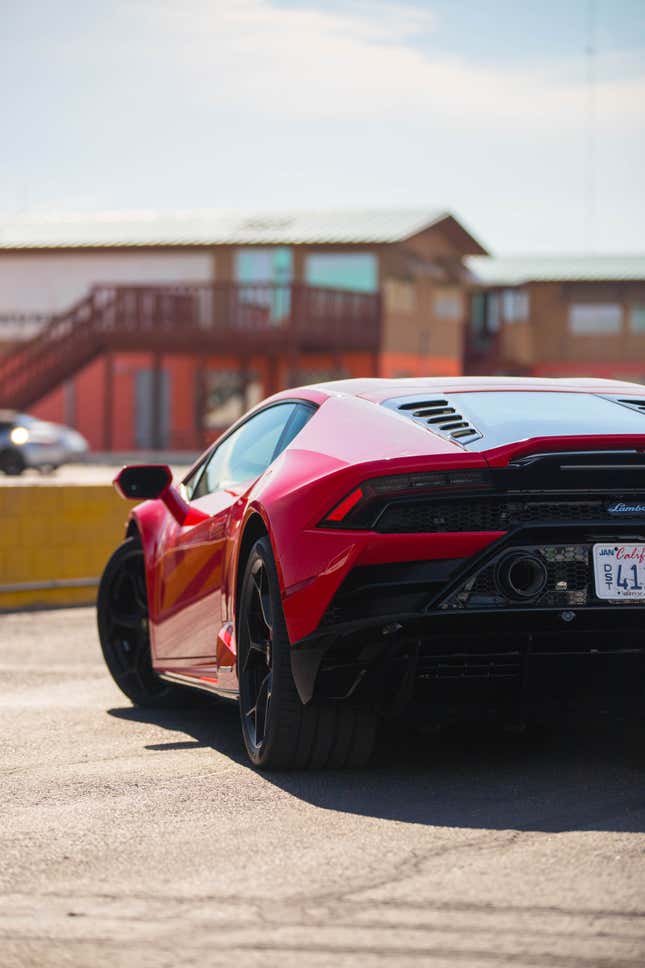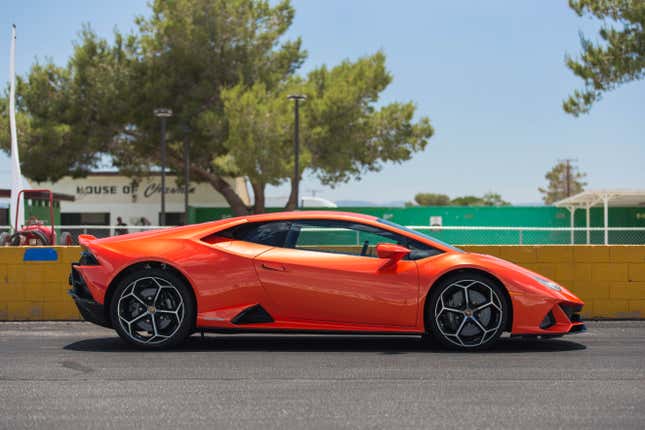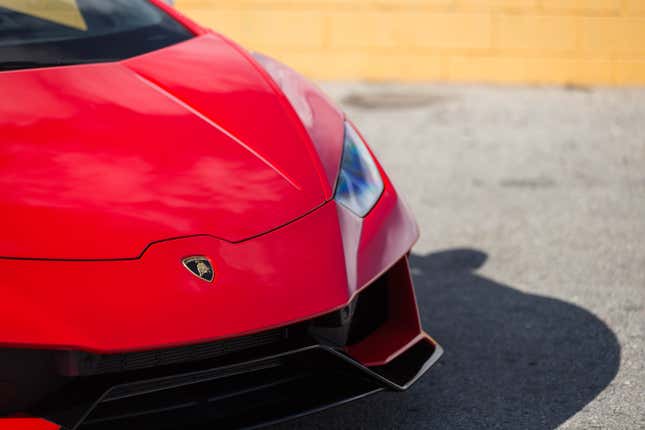I’m not fooled. Not one bit. I know the 2020 Lamborghini Huracán Evo is packed from pointy nose to upward-slanting tail with a bunch of technological gizmos that make it faster around the track than ever. But in an age of turbocharged and even hybrid everything, this car is still decidedly old school. And that’s what I love about it.
I tend to think of the supercar narrative as having an intense push and pull motion. On one end there are designers and engineers who work fanatically, pushing the envelope of what’s dynamically possible in their cars. A year when I think we’ve reached the pinnacle of speed and performance is another year that I’m proven wrong.
On the other, there’s also a pulling away from what was and what used to be.
(Full disclosure: Lamborghini flew me out to Los Angeles to drive its new car. The company put me up in a swanky Santa Monica hotel and fed me continuously. Then it bused me out to Big Willow, which it had rented out for us that day. Then it helicoptered us back to Santa Monica. Fancy Kristen was pleased. Regular Kristen was slightly air sick.)

That pulling away, that departure, is where a sense of profound anxiety and obsession over what is being left behind stems from. Behind the wheel of the Evo, that sense is more tangible than ever.
Duality
It’s 2019 and the amount of naturally aspirated, mid-engined supercars can be counted easily on one hand. Two of them even come from the same automaker and one of those shares an engine with the third. And the last is the relatively late arrival to the scene, the mid-engined Chevrolet C8 Corvette.
We find ourselves in an age that relies more and more heavily on electrification and other technological wizardry to create cars faster and more efficient than ever before. It’s an age the Huracán Evo currently resides in, but rather than give itself over to it wholly, the car appears to be a duality, straddling both this current era and the one that preceded it.
Just 15 years ago, the Evo’s recipe might not have earned it any extra-ordinary emphasis. But the fact that it still exists in today’s climate of hybridization and turbocharging, it stands out.
Free-Breathing Origins
When Lamborghini first set off making its mid-engine V10 supercars, it started with the Gallardo in 2003. It debuted with a naturally aspirated V10, but in those days, it also went toe-to-toe with the Carrera GT, the Ferrari 360 Modena, the Saleen S7, the Ferrari Enzo, the Pagani Zonda, the Lamborghini Murciélago and the Maserati MC12. All mid-engined. All naturally aspirated.
Having a naturally aspirated car then wasn’t a huge deal. Basically all of the supercars, mid- or front-engined, were not boosted. In fact, if you showed up with something supercharged or turbocharged, you’d be the odd one out. Those were the days when hybridization was for the Toyota Prius, not the high-power performance lords of the street and track.
Too soon, as time and innovation marched on, features that were once accepted as standard started to vanish. Manual transmissions. Non-hybridization. Unassisted, and then hydraulically assisted steering. Rear-wheel drive. Natural aspiration. The community, saturated with tradition-entrenched purists, looked on with trepidation as the much-loved ingredients of what constituted “fast” began to shift before their very eyes.
The naturally aspirated and technology-optional supercar era is closing fast. One by one, the Lamborghini’s normal-breathing competitors have fallen away, leaving the Huracán Evo one of the last members standing. By mere process of elimination, this is one worth paying attention to.
The Engine

With the new car, Lamborghini retired the alphabet soup naming system but did keep the wedge-shaped look. The Evo’s features are more sharply angled and evil than ever. It now has all-wheel steering and a very clever onboard system called the Lamborghini Dinamica Veicolo Integrata.
Basically, it’s a computer that precisely monitors all of the things the car’s up to (acceleration, roll, pitch, yaw, etc) and adjusts the torque vectoring, traction control and all-wheel drive for optimal driving.
Despite all the new tech, though, the car is ideologically retro.
The whole point of the Evo lives behind the driver. This is where the heart from the Huracán LP 640-4 Performante beats. It’s a 5.2-liter naturally aspirated V10 with 640 horsepower and 443 lb-ft of torque. That works out to 123 HP per liter and a sky-high redline of 8,250 rpm. This is what makes the car so special.
The V10 fires up with a roaring bark and an angry snap of hot air that shoots out of the raised exhaust tips. I know this because it caught me full in the face when I was crouched down behind one, trying to get a photo.
Behind the Wheel
Sitting in it, with the cabin awash in Alcantara, you can feel that engine, the life blood of the Evo, vibrating through the back of your seat and rattling your teeth in your head. Putting it in Sport mode only turns up the noise and vibration.
The all-wheel steering made the Evo feel much more petite than it was when navigating around Willow’s pit lanes. And out on the track, it felt like a dancer. There was already very little weight in the nose by design, but with the rear axle working around turns, there was a new sensation of rotation coming from the back I wasn’t used to. It wasn’t unpleasant, it just made the car feel like it was easier to tuck into tight corners at speed. It felt... twerkier. Sorry.
An 8,250-rpm redline is a lot of real estate to cover and you damn well won’t forget it, either. The engine is happy to caterwaul up and down the revs all day long, but nothing about it is ever spooky. There isn’t a sudden ZIP-WHAM-SMASH surge in power that you suddenly have to deal with as the turbos spool up. It’s just you and those 10 cylinders, working seamlessly together with everyone knowing what’s about to happen because delivery is so sweetly linear.
As atmospherically fast as the McLaren 720S is, I think I prefer the Lamborghini’s V10. There’s no guesswork associated with driving it, no delay. No surprises. Call me old-school.
And there really isn’t anything that can beat the yell of a free-breathing V10 engine. It’s the cylinder count that by far has the most dynamic range of aural outputs, with low gutturals all the way up to howling screams, a vocal range Apollo himself would be jealous of.
It’s a little bit ironic to me that Lamborghini would name its latest car the Evolution. I understand this is Lamborghini proclaiming its line is evolving with the times, but if that really were the case, the Huracán would have added some turbos or hybridized ages ago. To the immense gratitude of yabbos like me, it hasn’t. Not yet, at least.
Evolution Isn’t a Bad Thing
Modern Lamborghinis are notorious for growing long in the tooth, but in this case it is not a bad thing. Not especially when you consider what’s nestled between the two axles. The very idea of high-revving, naturally aspirated V10 is quite un-evolved, even if it is outfitted with the latest technology to coax out more power and efficiency.
Alessandro Farmeschi, Lamborghini’s CEO of the Americas, told me during the media launch that natural aspiration is the current solution. The dynamics, the sound—these are key to the experience. “This doesn’t mean there won’t be hybrids,” he said, however. Does that really come as a shock?
It’s easy to get swept up in what you’re afraid of losing. Recall the one very memorable Top Gear clip that had Jeremy Clarkson behind the wheel of an Aston Martin Vantage. The naturally aspirated V12 Vantage. The car is making all sorts of beautiful noises, soaring through beautiful landscapes. And then Clarkson speaks.

“What it makes me feel, though, is sad,” he declares. “I just can’t help thinking that... cars will this will soon be consigned to the history books. I just have this horrible, dreadful feeling that what I am driving here is an ending.”
“Goodnight,” he says after a pause for his words to take effect. And that’s how Season 13 ends. The first time I saw it, it left me with a sense of unspeakable dread.
Here’s the thing though. As much as naturally aspirated cars are amazing and sound like God, nobody said that what would come next would be worse. Just different.
Progress
Let us revisit the fact that cars are faster and more powerful than ever today. Ferrari recently dropped a hybrid and turbocharged, all-wheel drive car that makes almost 1,000 HP without breaking a sweat. Just because one aspect of a certain frontier closes doesn’t mean the whole thing suddenly comes off track. Supercars are just as obsessed with motion these days as they were in 2003, only the execution has changed.
Different eras will be forever ending when it comes to cars because that’s just how evolution works. That’s how progress works. There is wistfulness, certainly, when faced with the departure of things we liked or perhaps took for granted, and there’s anxiousness as to what will happen next.
Cars like the Evo won’t be around forever. Clarkson is right about that. But when they go, they’ll go to usher in something bigger and better than what we’d have thought possible. And we’ll all be just fine.
